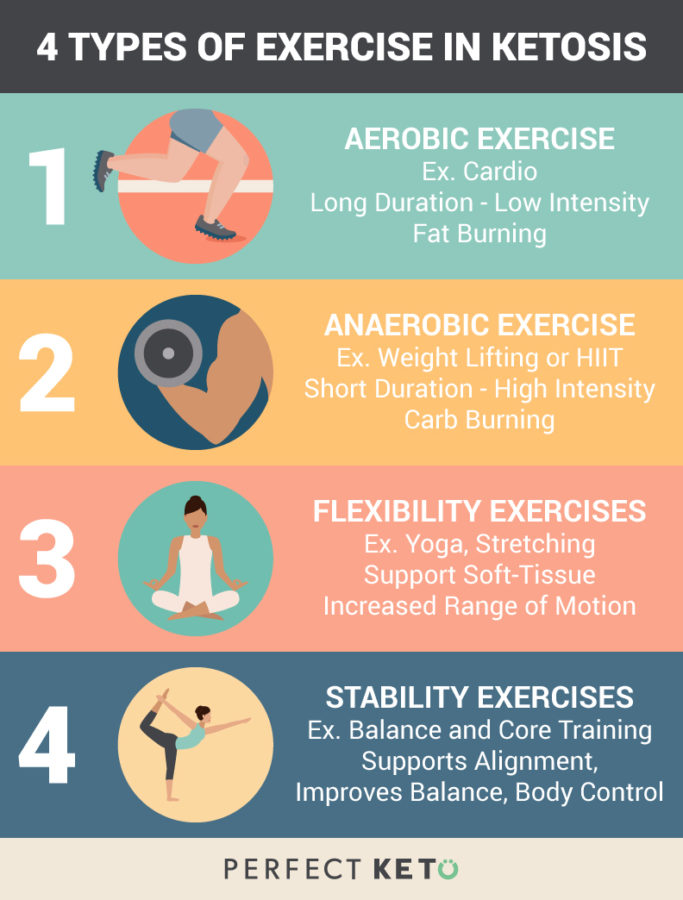Keto Diet and Exercise Results
- Exercising in Ketosis
- Targeted Ketogenic Diet and Athletic Performance
- Working Out on Keto: A Healthy Combination
Going keto means significantly reducing carbs. Since these macronutrients are the body's primary fuel source, you might be wondering about your best exercise options for working out on keto.

Need extra help?
Get our top 3 supplement recommendations for getting (and staying) in ketosis
The good news is that exercise is one of the most beneficial lifestyle choices you can make to complement your high-fat ketogenic diet and overall health.
Working out on keto can deliver great health benefits. To help you discover the advantages of a keto diet — and to debunk misconceptions — this guide offers the facts on low-carb diets and working out, especially when it comes to muscle building and carb intake.
Exercising in Ketosis
First, it's important to note that the traditional view of fat loss — eating less and exercising long er, often with long bouts of cardio — is outdated and unsustainable.
To see real results when it comes to losing weight and getting leaner, what you eat matters.
A great place to start is learning how to choose meat, dairy, and seafood. Paying attention to the quality of the foods you're consuming on a keto diet — and maintaining a steady state of ketosis — is the most important first step you can take.
Exercise is not only one of the crucial pillars of optimal health, but it also plays a vital role in your ketogenic way of living. It can improve cardiovascular health, help build lean body mass, strengthen your bones, and have an incredibly positive impact on your mental health[*][*][*].
Thankfully, working out on keto is possible and even advisable, especially when trying to avoid "keto flu" symptoms. You just need to keep in mind the next simple considerations.
Type of Exercise
Nutritional needs vary depending on the exercise type performed. Workout styles are typically divided into four types: aerobic, anaerobic, flexibility, and stability.

Aerobic exercise, also known as cardio exercise, is anything that lasts over 30 minutes. Low-intensity, steady-state cardio workouts can lead to an increase in fat burning, making it a great option for those whose main goal is weight loss[*].
Anaerobic exercise is characterized by shorter bursts of energy, such as strength training, CrossFit, or high-intensity interval training (HIIT). Carbs are the primary fuel for anaerobic exercise, so fat alone might not completely provide enough energy for this type of workout[*].
Take the keto quiz
Find the right keto snacks & supplements
for your unique goals
Take quiz
Flexibility exercises can stretch your muscles, support your joints, and improve your muscle range of motion. Yoga and simple after-workout stretches can increase your flexibility, thus helping to prevent injuries caused by the shortening of your muscles over time[*].
Stability exercises include balance exercises and core training. They can help improve your alignment, strengthen your muscles, and promote better control of your movements[*].
Carbs, Exercise, and Keto
When you're working out on keto, the intensity is vital:
- During low- to moderate-intensity workouts (aerobic exercise), the body uses fat as its primary energy source.
- During high-intensity workouts (anaerobic exercise), carbohydrates are usually the main source of energy.
When you're in ketosis, you're using body fat as your primary energy source. This can make high-intensity exercise a bit more challenging at the beginning of your keto journey. As such, it might have some side effects on your physical performance.
However, there is a solution for those who make anaerobic exercise the core of their activity plan. It's called the targeted ketogenic diet.
Targeted Ketogenic Diet and Athletic Performance
If you prefer higher intensity exercise (like sprinting or weightlifting) and enjoy working out more than three times a week, you may want to consider adjusting your keto diet to fit your carb needs. Sticking to the standard ketogenic diet won't likely be enough in your case.

Need extra help?
Get our top 3 supplement recommendations for getting (and staying) in ketosis
The best and most reliable way to figure out the optimal carb intake to support your lifestyle and health goals is to use a ketogenic calculator.
A keto calculator can help you figure out your macronutrients, support your weight loss journey, and give you an accurate value of how many carbs you should be eating.
How to Use a Targeted Ketogenic Diet for Exercise
While on the standard keto diet (SKD) you'd be sticking to 20-50 grams of net carbs per day, on a targeted ketogenic diet (TKD) these net carbs would have to be taken 30 minutes to one hour before high-intensity activities.
A good rule of thumb is to eat 15-30 grams of fast-acting carbs, such as fruit, within 30 minutes before your workout and within 30 minutes after. This will ensure you provide your muscles with the proper amount of glycogen to perform during the training and also during recovery.
Sticking to this time frame allows the carbs to be used exactly for this purpose and prevent any risk of getting kicked out of ketosis. Apart from this, you can continue with the standard keto diet ratios during the rest of the day.
For those who prefer low or moderate aerobic, flexibility, and stability activities, following a normal keto diet meal plan should be a good fit. Again, using a keto macro calculator is crucial to ensure you're picking the right diet version to support your health goals.
Health Benefits of Exercising in Ketosis
It might seem like ketosis is a hindrance to long-term exercise performance, but it has shown to provide significant benefits.
In one recent study, during a three-hour run, 2-3 times more fat burn was seen in ultra-endurance athletes who ate low-carb for an average of 20 months versus those following a high-carb diet. In the same study, the low-carb group used and replenished the same amount of muscle glycogen as the high-carb group[*].
Another study conducted in Australia showed that being in ketosis might help with blood glucose maintenance during exercise in people who suffer from obesity[*].
Plus, being in a state of ketosis has been shown to help prevent fatigue during long periods of aerobic exercise as well as help athletes recover after high-intensity workouts[*].
Working Out on Keto: A Healthy Combination
If you start following a low-carb, high-fat diet and have a passion for high-intensity training, it's important to fully understand which keto diet version is best for you.
Ketosis might get a bad rep in terms of exercise due to popular carb-heavy philosophies. But the truth is that it has a healthy place within a regular low or moderate exercise routine, and it can be easily adapted to fit the lifestyles of those who are more active.
It's critical to arm yourself with the best information possible about adopting a keto lifestyle and how you can reap all the amazing health benefits that it can bring.
The beauty of the ketogenic diet is that it's not a one-size-fits-all model. It just takes a little tweaking to find what works best for you.
This adaptability makes keto one of the most popular and sustainable diets. When combined with your preferred workout, it goes a long way towards a healthy and long-term lifestyle.
To learn more about keto and exercise, don't miss these informative articles:

Need extra help?
Get our top 3 supplement recommendations for getting (and staying) in ketosis
- The Cyclical Ketogenic Diet: Strategic Carb Intake for Keto Athletes
- Low-Impact Exercises for Weight Loss
- Complete Keto Exercise Plan for Keto Beginners
- Keto Gains: How to Build Muscle Without Carbs
Keto Diet and Exercise Results
Source: https://perfectketo.com/how-to-exercise-in-ketosis/